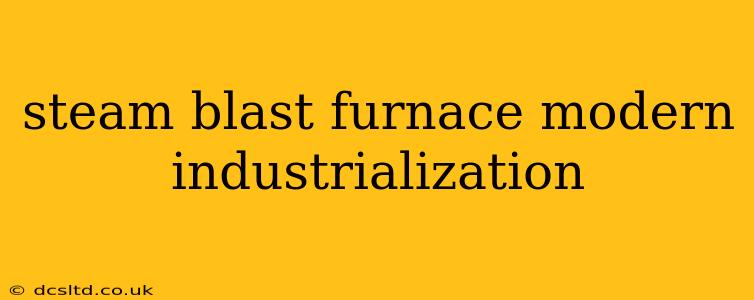The steam blast furnace represents a significant advancement in metallurgical processing, pushing the boundaries of modern industrialization. This technology leverages the power of steam injection alongside traditional blast furnace operations to achieve higher efficiency, reduced emissions, and enhanced productivity. This article delves into the intricacies of this innovative process, exploring its benefits, challenges, and future potential.
How Does a Steam Blast Furnace Work?
At its core, a steam blast furnace operates similarly to a conventional blast furnace, utilizing hot air to combust coke and reduce iron ore. However, the crucial difference lies in the injection of superheated steam alongside the hot air. This steam undergoes a series of reactions within the furnace, impacting several key aspects of the process:
- Enhanced Reduction: The steam reacts with the coke, producing carbon monoxide (CO) and hydrogen (H2), both potent reducing agents for iron ore. This supplementary reduction power boosts the overall efficiency of the iron-making process.
- Temperature Regulation: Steam injection can help moderate the temperature within the furnace, preventing overheating and improving the overall controllability of the process. This is especially crucial during periods of high production.
- Reduced Coke Consumption: By boosting the reduction efficiency, steam injection reduces the overall amount of coke needed, translating to significant cost savings and a smaller carbon footprint.
- Improved Gas Quality: The gas exiting the furnace is enriched with hydrogen, offering a more valuable fuel source for other industrial processes or power generation. This creates a more integrated and efficient industrial system.
What are the Benefits of Using a Steam Blast Furnace?
The advantages of steam blast furnace technology extend far beyond enhanced efficiency. They represent a significant step towards a more sustainable and economically viable future for the iron and steel industry:
- Environmental Benefits: Reduced coke consumption leads to lower CO2 emissions, a crucial step in mitigating climate change. The improved gas quality also enables more efficient energy utilization.
- Economic Advantages: Lower coke costs and increased production efficiency translate directly into higher profitability for steelmakers.
- Resource Efficiency: Steam blast furnaces utilize resources more effectively, maximizing the yield from raw materials.
- Technological Advancement: The technology showcases advancements in materials science and process control, leading to a more sophisticated and reliable iron-making process.
What are the Challenges in Implementing Steam Blast Furnace Technology?
Despite the clear advantages, implementing steam blast furnace technology faces certain challenges:
- High Initial Investment: The initial capital investment required for upgrading existing furnaces or building new ones can be substantial.
- Technical Expertise: Successful operation necessitates specialized technical expertise and skilled operators to manage the complexities of the process.
- Material Compatibility: The high temperatures and reactive environment within the furnace demand robust materials capable of withstanding the harsh conditions.
- Steam Generation: Efficient and reliable steam generation is crucial for seamless operation.
What is the Future of Steam Blast Furnace Technology?
The future looks promising for steam blast furnace technology. Continued research and development are focused on optimizing the process, improving efficiency, and addressing the challenges associated with implementation. We can expect to see:
- Improved Process Control: Advanced process control systems will allow for even more precise monitoring and optimization of the steam injection parameters.
- Integration with Renewable Energy: Utilizing renewable energy sources for steam generation will further reduce the carbon footprint of the process.
- Wider Adoption: As the technology matures and its benefits become more widely recognized, we can anticipate broader adoption across the steel industry.
Is Steam Injection in Blast Furnaces New Technology?
While the concept of steam injection isn't entirely new, modern advancements in materials science, process control, and steam generation techniques have made it a more viable and efficient technology for widespread industrial application. Early attempts faced limitations due to material constraints and less sophisticated control systems.
What are the Environmental Impacts of Steam Blast Furnaces?
The primary environmental benefit is a reduction in CO2 emissions due to decreased coke consumption. Furthermore, the improved quality of the off-gas reduces the overall environmental impact compared to traditional blast furnace operations. Ongoing research continues to explore methods for minimizing any remaining environmental effects.
How Does Steam Injection Affect the Efficiency of a Blast Furnace?
Steam injection significantly enhances the efficiency of a blast furnace by increasing the reduction rate of iron ore, reducing coke consumption, and improving the quality of the produced gas, resulting in substantial cost savings and environmental benefits.
This article provides a comprehensive overview of steam blast furnace technology. Further research and technological advancements will continue to refine this process, making it a cornerstone of sustainable industrial practices in the years to come.
